Microsoft 70-462 Exam Practice Questions (P. 3)
- Full Access (320 questions)
- Six months of Premium Access
- Access to one million comments
- Seamless ChatGPT Integration
- Ability to download PDF files
- Anki Flashcard files for revision
- No Captcha & No AdSense
- Advanced Exam Configuration
Question #21
You administer a Microsoft SQL Server database.
You use an OrderDetail table that has the following definition:

You need to create a non-clustered index on the SalesOrderID column in the OrderDetail table to include only rows that contain a value in the SpecialOfferID column.
Which four Transact-SQL statements should you use? (To answer, move the appropriate statements from the list of statements to the answer area and arrange them in the correct order.)
Select and Place:

According to these references, this answer looks correct.
References:
http://msdn.microsoft.com/en-us/library/ms188783.aspx
http://msdn.microsoft.com/en-us/library/ms189280.aspx

Hi! Do you need help with this question ?
- Why isn't the A the right answer?
- Traducir la pregunta al español
Contributor get free access to an augmented ChatGPT 4 trained with the latest IT Questions.
Question #22
You administer a Microsoft SQL Server database.
The database contains a table that has the following definition:
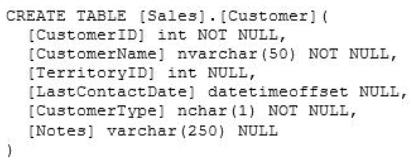
You want to export data from the table to a flat file by using the SQL Server Import and Export Wizard.
You need to ensure that the following requirements are met:
✑ The first row of the file contains the first row of data.
✑ Each record is of the same length.
✑ The date follows the U.S. date format.
✑ The file supports international characters.
What should you do? (To answer, configure the appropriate option or options in the dialog box in the answer area.)
Hot Area:
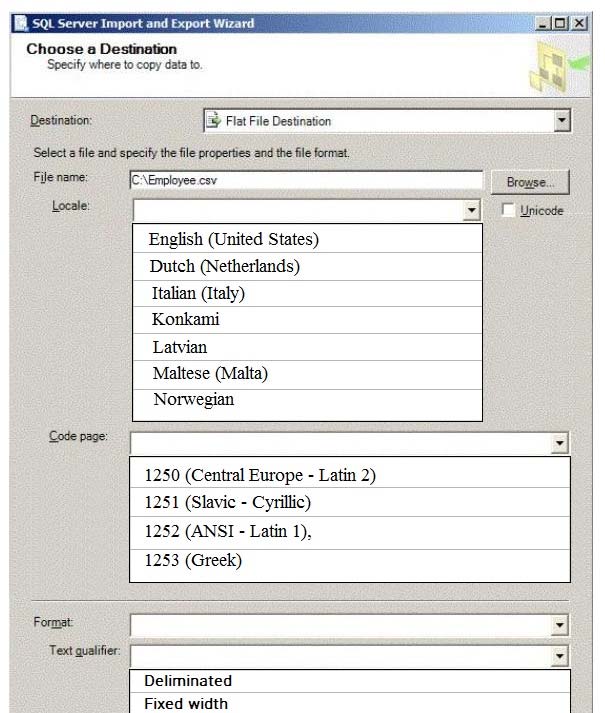
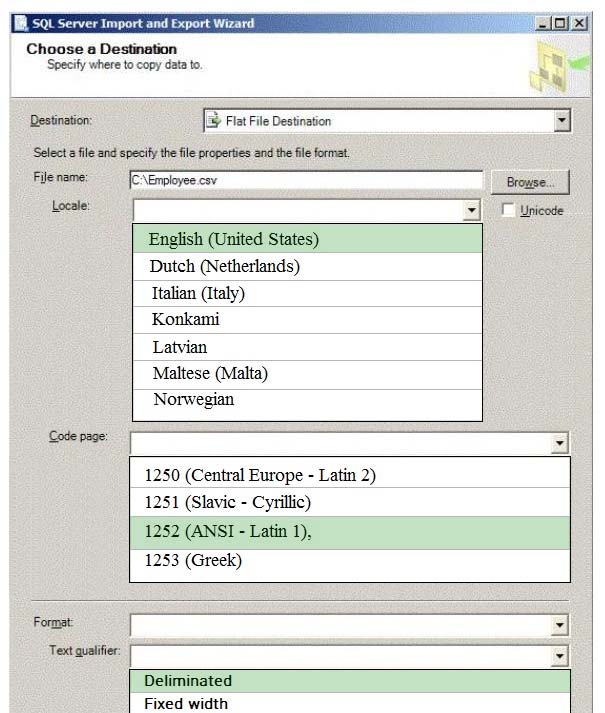
References:
http://msdn.microsoft.com/en-us/library/ms178804.aspx
http://msdn.microsoft.com/en-us/library/ms187828.aspx

Hi! Do you need help with this question ?
- Why isn't the A the right answer?
- Traducir la pregunta al español
Contributor get free access to an augmented ChatGPT 4 trained with the latest IT Questions.
Question #23
UserB. You also have a stored procedure named GetCustomerOrderInfo owned by UserB. GetCustomerOrderInfo selects data from both tables.
You create a new user named UserC.
You need to ensure that UserC can call the GetCustomerOrderInfo stored procedure. You also need to assign only the minimum required permissions to UserC.
Which permission or permissions should you assign to UserC? Each correct answer presents part of the solution.
- AThe Select permission on Customers
- BThe Execute permission on GetCustomerOrderInfo
- CThe Take Ownership permission on Customers
- DThe Control permission on GetCustomerOrderInfo
- EThe Take Ownership permission on Orders
- FThe Select permission on Orders
B
Execute permission on the Stored procedure is the minimal permission that is required. Select permission is not necessary.
References:
http://msdn.microsoft.com/en-us/library/ms188676.aspx
http://stackoverflow.com/questions/2212044/sql-server-how-to-permission-schemas http://sqlservercentral.com/blogs/steve_jones/2012/03/14/ownership-chains-in-sql-server

Hi! Do you need help with this question ?
- Why isn't the A the right answer?
- Traducir la pregunta al español
Contributor get free access to an augmented ChatGPT 4 trained with the latest IT Questions.
Question #24
Purchases schemA.
You create a new user named ContosoUser in ContosoDB. ContosoUser has no permissions to the Suppliers table.
You need to ensure that ContosoUser can delete rows that are not active from Suppliers. You also need to grant ContosoUser only the minimum required permissions.
Which Transact-SQL statement should you use?
- AGRANT DELETE ON Purchases. Suppliers TC ContosoUser
- BCREATE PROCEDURE Purchases.PurgeInactiveSuppliers WITH EXECUTE AS USER = 'dbo' AS DELETE FROM Purchases.Suppliers WHERE IsActive = 0 GO GRANT EXECUTE ON Purchases.PurgelnactiveSuppliers TO ContosoUser
- CGRANT SELECT ON Purchases.Suppliers TO ContosoUser
- DCREATE PROCEDURE Purchases. PurgeInactiveSuppliers AS DELETE FROM Purchases.Suppliers WHERE IsActive = 0 GO GRANT EXECUTE ON Purchases. PurgeInactiveSuppliers TO ContosoUser
D
References:
http://msdn.microsoft.com/en-us/library/ms188354.aspx
http://msdn.microsoft.com/en-us/library/ms187926.aspx

Hi! Do you need help with this question ?
- Why isn't the A the right answer?
- Traducir la pregunta al español
Contributor get free access to an augmented ChatGPT 4 trained with the latest IT Questions.
Question #25
You need to create a user who can log on to the ContosoDb database. You also need to ensure that you can port the database to different database servers within the domain without additional user account configurations.
Which type of user should you create?
- AUser mapped to a certificate
- BSQL user without login
- CDomain user
- DSQL user with login
C

Hi! Do you need help with this question ?
- Why isn't the A the right answer?
- Traducir la pregunta al español
Contributor get free access to an augmented ChatGPT 4 trained with the latest IT Questions.
Question #26
Some users must be prevented from deleting records in any of the tables in the Sales schema.
You need to manage users who are prevented from deleting records in the Sales schema. You need to achieve this goal by using the minimum amount of administrative effort.
What should you do?
- ACreate a custom database role that includes the users. Deny Delete permissions on the Sales schema for the custom database role.
- BInclude the Sales schema as an owned schema for the db_denydatawriter role. Add the users to the db_denydatawriter role.
- CDeny Delete permissions on each table in the Sales schema for each user.
- DCreate a custom database role that includes the users. Deny Delete permissions on each table in the Sales schema for the custom database role.
A

Hi! Do you need help with this question ?
- Why isn't the A the right answer?
- Traducir la pregunta al español
Contributor get free access to an augmented ChatGPT 4 trained with the latest IT Questions.
Question #27
All DBAs are members of the DOMAIN\JrDBAs Active Directory group. You grant DOMAIN\JrDBAs access to the SQL Server.
You need to create a server role named SpecialDBARole that can perform the following functions:
View all databases.

✑ View the server state.
✑ Assign GRANT, DENY, and REVOKE permissions on logins.
You need to add DOMAIN\JrDBAs to the server role. You also need to provide the least level of privileges necessary.
Which three SQL statements should you use? Each correct answer presents part of the solution.
- AGRANT VIEW ANY DATABASE TO [SpecialDBARole];
- BGRANT VIEW SERVER STATE, VIEW ANY DATABASE TO [SpecialDBARole];
- CCREATE SERVER ROLE [SpecialDBARole] AUTHORIZATION securityadmin;
- DCREATE SERVER ROLE [SpecialDBARole] AUTHORIZATION sysadmin;
- EALTER SERVER ROLE [SpecialDBARole] ADD MEMBER [DOMAIN\JrDBAs];
- FCREATE SERVER ROLE [SpecialDBARole];
BCE

Hi! Do you need help with this question ?
- Why isn't the A the right answer?
- Traducir la pregunta al español
Contributor get free access to an augmented ChatGPT 4 trained with the latest IT Questions.
Question #28
You administer a Microsoft SQL Server 2012 database.
All database traffic to the SQL Server must be encrypted by using secure socket layer (SSL) certificates or the connection must be refused.
Network administrators have deployed server certificates to the Windows store of all Windows servers on the network from a trusted Certificate Authority. This is the only Certificate Authority allowed to distribute certificates on the network.
You enable the Force Encryption flag for the MSSQLServer protocols, but client computers are unable to connect. They receive the following error message:
"A connection was successfully established with the server, but then an error occurred during the pre-login handshake.
(provider: SSL Provider, error: 0 - The certificate chain was issued by an authority that is not trusted.) (Microsoft
SQL Server)"
You notice the following entry in the SQL Server log:
"A self-generated certificate was successfully loaded for encryption."
You need to configure SQL Server to encrypt all client traffic across the network.
You also need to ensure that client computers are able to connect to the server by using a trusted certificate.
Which three actions should you perform in sequence? (To answer, move the appropriate actions from the list of actions to the answer area and arrange them in the correct order.)
Select and Place:
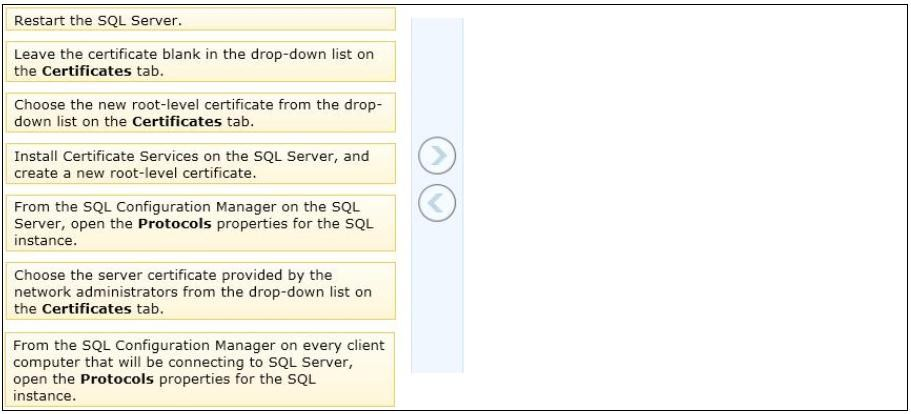
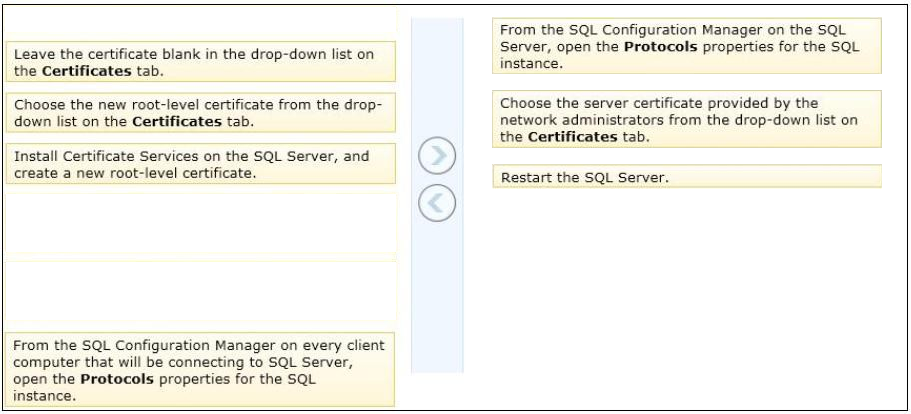
Reference:
http://thesqldude.com/2012/04/21/setting-up-ssl-encryption-for-sql-server-using-certificates-issuestips-tricks/

Hi! Do you need help with this question ?
- Why isn't the A the right answer?
- Traducir la pregunta al español
Contributor get free access to an augmented ChatGPT 4 trained with the latest IT Questions.
Question #29
Dynamic Management Views.
You grant User1 access to execute the stored procedure.
You need to ensure that the stored procedure returns the required information when User1 executes the stored procedure. You need to achieve this goal by granting the minimum permissions required.
Which two actions should you perform? Each correct answer presents part of the solution.
- AGrant the VIEW SERVER STATE permission to User1.
- BMove the stored procedure to the User1 schema.
- CModify the stored procedure to include the EXECUTE AS OWNER statement. Grant VIEW SERVER STATE permissions to the owner of the stored procedure.
- DGrant the db_datareader role on the database to User1.
- ECreate a SQL Server login that has VIEW SERVER STATE permissions. Modify the stored procedure to include the EXECUTE AS (newlogin) statement.
CE
References:
http://msdn.microsoft.com/en-us/library/ms187861.aspx
http://msdn.microsoft.com/en-us/library/ms191291.aspx

Hi! Do you need help with this question ?
- Why isn't the A the right answer?
- Traducir la pregunta al español
Contributor get free access to an augmented ChatGPT 4 trained with the latest IT Questions.
Question #30
You attempt to add the [Corpnet\User1] login to the database. However, you receive the following error message:
"User already exists in current database."
You need to configure the [Corpnet\User1] login to be able to access the Orders database and retain the original permissions. You need to achieve this goal by using the minimum required permissions.
Which Transact-SQL statement should you use?
- ADROP USER [User1]; CREATE USER [Corpnet\User1] FOR LOGIN [Corpnet\User1]; ALTER ROLE [db_owner] ADD MEM3ER [Corpnet\User1];
- BALTER SERVER RCLS Isysadmin] ADD MEMBER [Corpnet\User1];
- CALTER USER [Corpnet\User1] WITH LOGIN [Corpnet\User1];
- DALTER ROLE [db owner] ADD MEMBBR [Corpnet\User1]; C
Explanation
Reference:
http://msdn.microsoft.com/en-us/library/ms176060.aspx

Hi! Do you need help with this question ?
- Why isn't the A the right answer?
- Traducir la pregunta al español
Contributor get free access to an augmented ChatGPT 4 trained with the latest IT Questions.
All Pages
